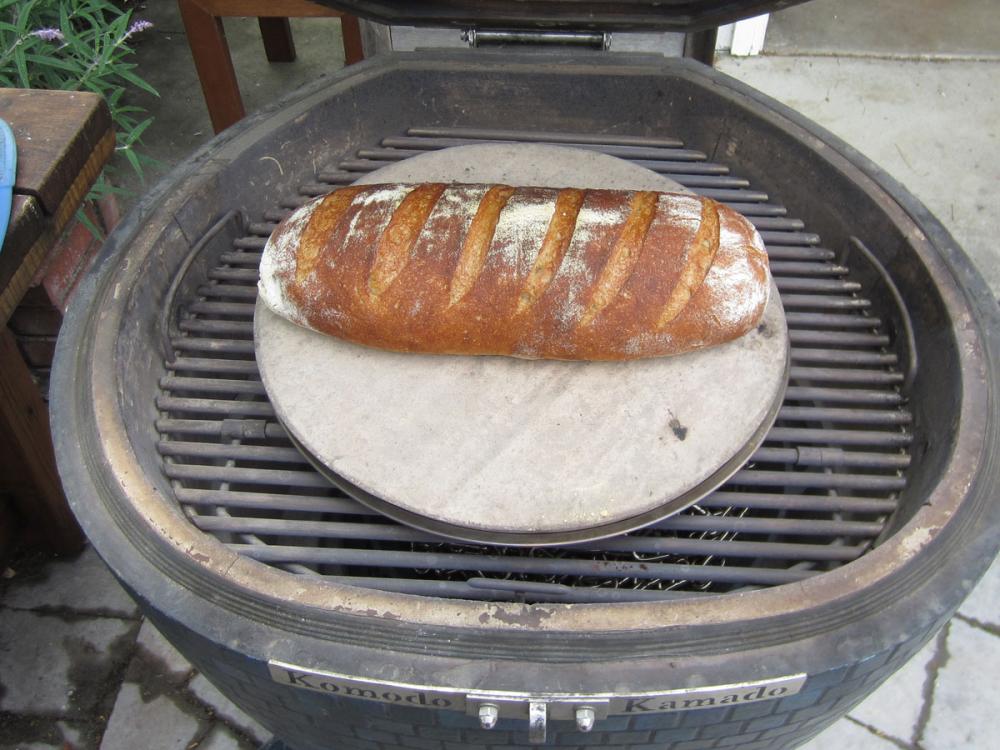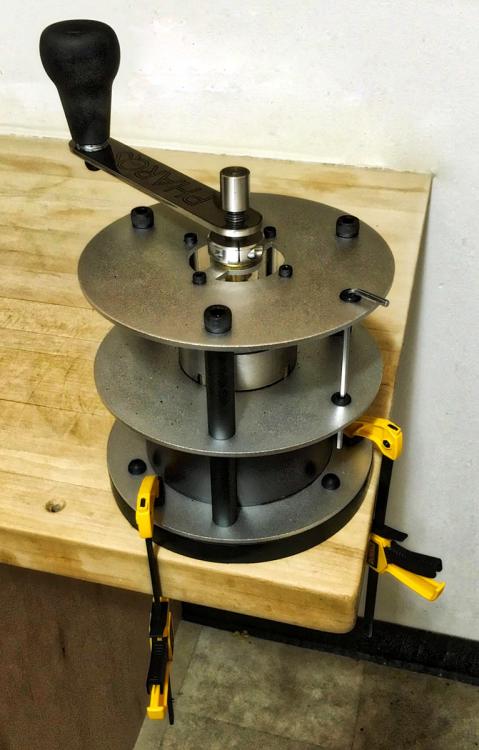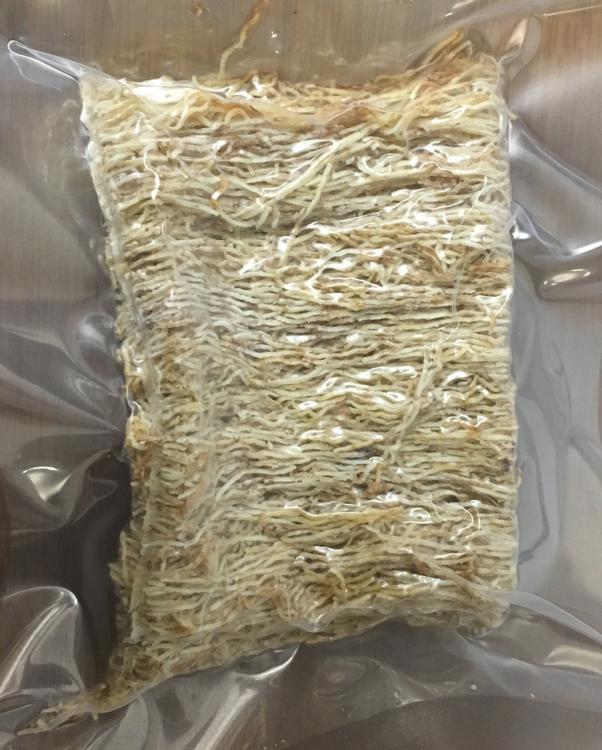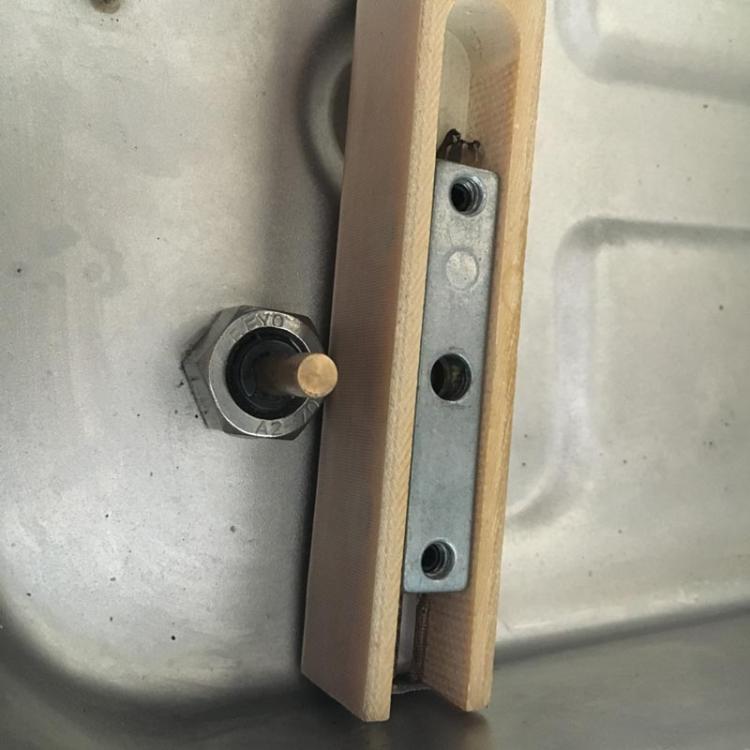-
Posts
1,739 -
Joined
-
Last visited
-
Days Won
53
Content Type
Profiles
Forums
Events
Everything posted by Syzygies
-
Tartine Book No. 3: Modern Ancient Classic Whole Amazon has many Kindle books on sale for Cyber Monday, and I picked up Tartine Book No. 3 for $3. Some amazing extensions on what various of us here have been doing with bread: Fermented porridge, ancient grains. I'm excited to try some of these ideas.
-
The ice is a nice slow fuse, enough time to get the KK closed again. I like a thin flat slab, formed in a ziplock bag or a chamber vacuum bag (sealed with an impulse sealer as one would for freezing stock). A thin slab will melt sooner than a block of ice, and one does want the steam at the very beginning of the bake. A theory review: Commercial bread ovens introduce ample steam at the beginning of a bake. Baking a boule in a cast iron pot is one home fix for this, effective but not quite the same. While this is associated with "no knead" breads, the Tartine Bread book (now $2.99 on the Kindle) has a fresh take on kneaded loaves (similar to ours) and also advocates baking in a cast iron pot. Instead introducing ample steam allows arbitrary bread shapes, multiple loaves. We routinely make two bâtards. The idea of using ample steam at home was recently popularized by the Bouchon Bakery cookbook, though it can be found in earlier professional sources. 350g of water will produce enough steam to fill a home oven or a 23" KK several times over. In contrast, a few spritzes from a spray bottle will be 10g of water if one is lucky. Scale matters. It takes 80 calories to thaw a gram of ice, 100 calories to bring that gram to the boiling point, and a whopping 540 calories to then turn that gram of water to steam. By weight, steel holds about 13% as much heat energy as water. These numbers explain why one needs so much metal to boil the water, and why it hardly matters whether the water starts out as ice or hot water.
-
Try sealing the grates in a contractor trash bag, along with a bowl of ammonia. As for a tub, water heater drain pans are perfect for 23" KK grates. One does have to improvise a way to plug the hole.
-
I mix paste just before use, in a ziplock sandwich bag. Start with some white flour, dribble in tap water till the texture massages to a wet paste, stiffer than toothpaste. Then I nick a corner, to squeeze a bead around the lid rim. I pretty much forget to do any routine at least once, and notice if it didn't matter. I find that the paste matters, as others observe. If I don't seal on the lid, I sometimes get convection through the pot. I have daydreamed about stabilizing the paste with some food safe preservative, and loading up a "u fill it" toothpaste tube, so paste is always ready. One would think these tubes would be easiest to find at outdoor stores, but I usually see them in artist supply stores. Artists like to mix up their own paints, for example.
-
I'm likely to order a pallet of charcoal to arrive mid-December in Concord, CA (half hour east of Berkeley, ten minutes north of Walnut Creek). I have enough extruded coconut to get through another decade, but only a few boxes of coffee lump, which I'm increasingly unable to live without. I can probably store a large enough order for shipping rates to flatten out, but it's always fun to meet other owners, and sharing helps bring the shipping down further. I'm posting now, a month before I want to take delivery, because I've seen that these shares tend to organize slowly. Early December, them's the bus schedule. Are you on the bus?
-
Hey, don't look at me. I've already cast blame elsewhere!
-
I don't actually know, because I can't use a 58mm basket. Your post sent me into an exploring spiral, and I believed what EspressoForge proposed was an upgrade. For the La Pavoni, I just ordered a couple of larger capacity 49mm Elektra Microcasa double baskets. It appears my portafilter is deep enough, but if not I'll get a bottomless portafilter. Being able to use 58mm baskets is parallel to my home torchio pasta extruder taking standard "Dolly" brass pasta extruder dies. Pricey but lots more choices. Pasta has actually been the constant in my life; we grind our own flour using a KoMo Classic Grain Mill (nothing less expensive works acceptably), sieving out some bran for a fixed extraction using a Gilson 12in Round Test Sieve over a Vollrath 69080 8 Quart Mixing Bowl. (I have several sets of these fine bowls. A friend cut corners matching them, and his wife could tell.) To be honest, barbecue is a peripheral hobby for me, like coffee, I just have this issue where I get obsessed with whatever I'm thinking about at the moment. In other words, this is all your fault. How does the EspressoForge actually compare (critically, if you're counseling someone who might spend the $300 but doesn't have to) with other machines not costing thousands of dollars?
-
Wow. I actually believe that my coffee activities are casual, get in and get out, but you're probably the only person who would see it that way. The Kafatek looks amazing but out of budget. Where did you get the Mahgut Grist? It looks like what Orphan Espresso meant to do. (I left out the part of the story where my blind return sat on Orphan's country house porch for months while they were in Asia, because I stripped the adjustment screw and I was too pissed to fix it myself.) At the dawn of the internet (around the time Jeff Bezos decided to open an online bookstore) I wrote this Pavoni web page as an experiment in web authorship: Coffee: Resources for home espresso
-
So do you have your Reg Barber tamper yet? Reg Barber coffee tampers I'd go with the Decent Espresso double baskets, which call for a 58.5mm tamper. My friends argue endlessly about the best tamper shape, but I went flat. Decent Espresso basket That Espresso Forge looks very interesting. I like how it uses standard parts, like my Venetian Bigolaro pasta extruder. My morning ritual involves a Pavoni Europicola lever espresso machine, and an Orphan Espresso Pharos grinder. That's a $300 manual grinder that sports conical burrs normally found in $3,000 motorized grinders. It was a nightmare to get into a routine (Dewalt small trigger clamps to fix it to my butcher block, a mister to prevent bean static, a 600ml Bamix immersion blender beaker to snugly receive the grinds while I shake) but now I have it down, and the routine is what wakes me up. The coffee is a bonus. Orphan Espresso Pharos
-
The double-walled drip pan is on my short list. What I have long used is a 16" terra cotta plant saucer (plain from Italy; one doesn't want lead) lined with a couple layers of heavy duty aluminum foil. The foil makes for easy cleanup. The saucer cracks every year or two and I replace it.
-
I gave up on fat separators long ago. I rely on "leverage". Find a ladle or ladle-like spoon that fits into a large glass or measuring cup. If one is buying from scratch for this, buy a "jam jar" glass and one of those hanging stainless steel ladles ending in a half sphere spoon, that fits partway into the glass. Now, use the ladle to skim the surface of the stock, by setting it just far enough into the stock for the very top film of stock to flow into the ladle. Do this all over the surface, pouring the result into the cup. The goal here is to eventually get all the fat, and some of the stock. It's ok if one ends up with half fat, half stock in the cup. That's a huge improvement on the ratio in the stock pot. Now, let the fat rise to the top, in the cup, and this time ladle off just the fat. Be conservative; one you've removed most of the fat you can always add more stock, to get the remaining fat near the surface. Or one can just dump the stock and bits of remaining fat back into the stock pot, and do this again. This is way easier to do that to say. Why it works is obvious once you see it in action. I can't imagine dedicating space in my kitchen to a bulky fat separator that doesn't work as well.
-
I think mine is named Kay, but I'm not sure. We never consciously named it. We've named every GPS Audrey; I have no idea why. Some things should be left unnamed. One can go either way with a cooker.
-
If a $10 little bottle of spices could make an ordinary meat source taste like a special meat source, it would be worth every penny. This hasn't been my experience, which is one reasone that I buy meats from artisanal local sources. Even the bump in price for the cheap cuts is more that the spices would cost if they worked. I love spice-centered cuisines like Moroccan or Indian, and like flour I grind my own spices when possible. I have a psychological block to plain-cooking an ingredient for dinner, rather than cooking a recipe. Nevertheless, my bias is that the best barbecue doesn't depend on complex spicing. Instead, one cooks an ideal piece of meat with no more than salt, pepper, and chiles, controlling the fire and smoke to the best of one's ability, and letting the meat speak for itself. This is the ideal described in Legends of Texas Barbecue Cookbook, served out the back door on butcher paper to area workers. I don't like flavored coffees, or flavored olive oils, or dehydrated garlic and onions, and I bring this suspicion to store-bought rubs for barbecue. They remind me of the middle ages: One perhaps rightly feared baths as an infection vector, but humans smelling like healthy wild animals had fallen out of favor, so one masked with perfumes. Nevertheless, one could generalize the idea of "umami" to any subliminal technique that enhances a flavor. And as noted above, the best practitioners of spice blending may have talents beyond us. So I'll decide one blend from the recommendations above, and try it. Always good to fight one's prejudices...
-
I keep a "food" folder that syncs with all my computers. Spreadsheets where appropriate, for salting meats or tweaking sourdough bread recipes. I either scan pages from physical cookbooks or screen grab pages from Kindle books, and I always cook from a printout taped to a cupboard door when following a recipe. I mark it up as I go, and I usually then scan it to save with other text file notes which I consult before the next similar cook. One advantage to this is that my physical cookbooks are in one home or the other, and with a scan I'm able to make favorite recipes again on the other coast.
-

Help with failing Vacmaster VP115 ?
Syzygies replied to Syzygies's topic in Relevant Product Reviews
Now that my chamber machine is working again, I'm going around the house looking for things to vacuum pack. (When Border Collies don't have work to do, they become bored and destructive.) Who knew that shredded wheat crackles for minutes after you vacuum pack it? -
Yes, that has been my path too, although my K7 fell apart faster. I visited East Germany just after the wall fell. It was common in those days to buy a BMW in West Germany, drive it while on vacation, then have it shipped home. I tried telling my hosts with a straight face that I wanted to do the same thing with a Trabant. (Remember the car-casses lining the road to freedom, as people overloaded Trabants while fleeing, and they broke down?) The K7 was my Trabant, my KK is my BMW. My KK works a lot better than my K7 ever did. All the little things. You'll have no regrets if you decide to switch.
-

Help with failing Vacmaster VP115 ?
Syzygies replied to Syzygies's topic in Relevant Product Reviews
I can now answer my own question. One can see how the sealing action works by removing the sealing bar, and watching the machine run empty. The sealing bar rests on two brass piston rods (one is shown above, next to the underside of the sealing bar). These lift up the sealing bar when the time comes to seal. In theory, before this there is enough clearance for air to escape bags in the chamber. The foam in my new lid stuck out an extra 1/8" further than the foam in my old lid. This removed the necessary clearance, so air wouldn't escape the bag, causing the machine to fail to work properly. We ended up unscrewing the new sealing pad assembly, and sticking the old sealing pad into the recess. It stays in place without adhesive (so far!), and I get the needed extra clearance. So why did I change lids? Dunno. Moving forward, it was enough of a nuisance swapping lids (the arms fell into the machine, and it was a dexterity challenge to reach them) that I'm happy not to have to swap the old lid back on. -
I'm hoping others here understand better than I do how chamber vacuum sealers work. I have a two year old VacMaster VP115 (their current model is the VP120). The seal pad fell out. I ordered a replacement, but it turns out there were too many variants to count for the VP115, and they don't have replacement seal pads for my exact version. They kindly sent me a new lid. Before the new lid arrived, I would simply line up the fallen seal pad, and the machine would usually work. When it didn't, the bag would still have air in it. I didn't understand why at the time. With the new lid, this is an unavoidable problem: While the pump is running, the seal pad clamps the bag end so tightly against the sealing strip that some of the air can't escape the bag. It puffs up like the first Soviet space walk, and there's still air in the bag after the cycle finishes. I am certain that I'm getting a good vacuum, as the pressure gauge shows the same performance as usual. As one knows if one has such a machine, the lid pulls down with considerable force while the pump is running. So this is one of those things that one doesn't think about, while it works. Then, I wonder how the hell it ever worked? (I'm sure glad my career wasn't managing photocopier paper paths, I like engineering but I loathe this sort of poorly behaved problem.) I can't imagine that any manufacturer would be stupid enough to leave this tolerance to chance. Therefore, I'm wondering if the two lid arms have a responsibility to resist the vacuum, enough to keep bags open during the pump cycle so air can escape. If this is the case, then my arms are busted. Or at least in need of repair or a tuneup. The "elbow" bolt assemblies look pretty loose. Hey, you put up with my speculation, so of course I'll humor anyone else's speculation. I'm hoping, as is so often the case on this forum, someone actually knows!
-
Willie Nelson!
-

Coffee Wood LUMP Charcoal ~ In Stock
Syzygies replied to DennisLinkletter's topic in KK Announcements
For residential we DON'T check "Liftgate required", right? It would add $25 to my shipping. I see $138 for small orders to Concord, CA, climbing to $150 for 25 to 35 boxes, $170 for 40 boxes. In other words, shipping adds $14 each for 10 boxes, $7 each for 20 boxes, $5 each for 30 boxes, $4.25 each for 40 boxes. Clearly, the question is can I find room to store 30 boxes? -
Yes. The cold smoker sounds to me like the BBQ Guru: One doesn't need either, but if one has either, and doesn't mind the setup, it nails the problem. I haven't tried the cold smoker yet, though I've been on the verge of buying one. I keep thinking that it doesn't solve any problems for me that I don't already have covered (I don't actually want to cold smoke). On the other hand, for introducing smoke to higher temp cooks where I wouldn't have dared before, or for fresh smoke toward the end of a long cook? I'd believe it if someone told me that the cold smoker makes better brisket, and that alone would be a justification. This is an empirical question...
-
Nice! It sounds like you've got this pipe seasoned nicely. What you describe reminds me of threads I found when the Baking Steel first came out. People who were outraged at the pricing described how one could clean up steel plate from local metal worker suppliers. It took some effort! I'm happy with the smoke output from a two quart Dutch oven, for low & slow cooks, but I get too much smoke about 275 F. So if you're looking for the same effect at 300 F, a small unit like this could be the ticket. Another idea for how to do this (I haven't tried this, but I've been meaning to): Replace the original cap on a stainless steel klean kanteen with their stainless steel cap. Drill a few 1/8" holes along one side of the canteen, exactly like the smoke bomb. Even if the cap gets wedged on from expansion and cooling, one can insert a screwdriver through the loop to help free it. Klean Kanteen Stainless Steel Bottle with Loop Cap Kleen Kanteen All-Stainless Steel Loop Cap
-
Nice idea! Long term, I have concerns about which metals see the inside of my KK. I've heard that anything chrome-plated off-gases substances one doesn't want on one's food. My simplistic theory of bolts is that they're either "stainless steel" or "don't ask". There are variations in quality for either, but I stick to pure metals (cast iron, stainless steel) inside my KK. Bolts I have around, I simply don't know. Years ago, another solution to avoiding flour paste for the lid was to make a "smoke bomb", what would be a pipe bomb if there weren't three little holes along the bottom (don't forget!). Fill with smoking wood, screw on the cap. These were made from stainless steel for the above reasons, and thus very expensive. I like flour paste. It reminds me of how Moroccans would use pots that didn't fit, steaming couscous. And whenever I flinch at a few steps in cooking, I remind myself that the entirety of my manual dexterity tasks for a day is no match for ten minutes of practice by a concert pianist. Humbled, I just get it done.
-
Bro, we're on the same journey. The KFF featured my K7 mortar job for a bit, then took it down out of imagined concern for my feelings. Nah, I was proud! You have arrived in a safe port filled with wonderful people. Welcome.
-
I usually light the charcoal with a weed burner, aiming right under the smoke pot, and generously missing, dousing the pot itself with flames. Addressing this issue, I haven't had any problems with insufficient smoke at 225 F, using a two quart pot. At a friend's house, he was trying to cook four butts on an old K5. I advised a thorough preheat, so to catch up the smoke pot we put in later, we heated it as hot as we could get it in a gas grill, then moved it. This also worked.








